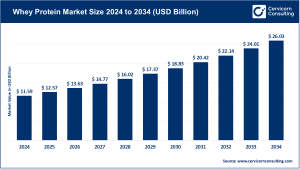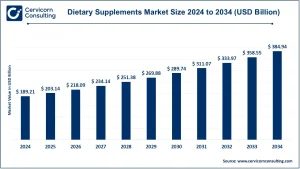Market Overview
The global herbal extract market was valued at USD 32.11 billion in 2024. It is projected to reach USD 67.86 billion by 2034, expanding at a CAGR of 7.77% between 2025 and 2034.
Herbal extracts—concentrated bioactive components derived from plants in forms such as powders, liquids, oleoresins, essential oils, and tinctures—are increasingly utilized in pharmaceuticals, nutraceuticals, food and beverages, cosmetics, and personal care products. This expansion marks the shift of botanical ingredients from niche natural remedies to essential components in mainstream consumer industries.
Get a Free Sample: https://www.cervicornconsulting.com/sample/2436
Key Market Trends
- Advancements in Extraction and Standardization Technologies
Cutting-edge extraction techniques such as supercritical CO₂ extraction and green solvent technologies are enhancing product purity, yield, and consistency. These innovations help manufacturers meet strict quality and regulatory requirements, while reducing waste. Cervicorn Consulting identifies these technological advancements as a major contributor to market expansion. - Heightened Regulatory Focus and Quality Assurance
With herbal extracts now used in mainstream health, food, and cosmetic products, regulatory oversight and certification standards are tightening. As only about 5% of medicinal plants have been fully researched, demand is rising for standardized and traceable extracts backed by scientific validation. - Growing Consumer Demand for Natural and Clean-Label Products
A global shift toward natural, plant-based, and chemical-free products is driving adoption in sectors such as nutraceuticals and personal care. Cervicorn Consulting notes that wellness-oriented extracts like ashwagandha, turmeric, and ginseng are experiencing significant post-pandemic demand due to their health benefits. - Asia-Pacific Market Leadership
The Asia-Pacific region holds roughly 47.6% of global revenue (2024), fueled by strong sourcing capabilities in China and India and growing domestic consumption. This dominance is reshaping global supply chains and influencing production costs and regulatory frameworks. - Cross-Industry Convergence
Herbal extracts are increasingly being adopted across diverse industries—from functional foods and beverages to cosmetics and pharmaceuticals. Cervicorn highlights that the personal care and cosmetics segment accounted for nearly 30.70% of total market revenue in 2024, reflecting rising demand for plant-derived actives.
Market Drivers
- Rising Demand for Botanical Ingredients
Heightened health awareness and preference for natural alternatives to synthetic chemicals are driving the adoption of herbal ingredients. Cervicorn Consulting cites increased interest in immunity-boosting and stress-relief extracts as a major driver. - Expansion Across End-Use Sectors
Integration of herbal extracts into food & beverages, nutraceuticals, cosmetics, and pharmaceuticals is broadening the market base. The phytomedicines segment alone captured ~35.72% of total revenue in 2024. - Technological Innovation in Extraction
Modern extraction and processing technologies improve efficiency, quality, and scalability, enabling entry of new suppliers and expansion into specialized high-value applications. - Regional Sourcing and Cost Advantages
Asia-Pacific remains the manufacturing hub, leveraging traditional herbal knowledge, agricultural resources, and cost-efficient production. The region’s market value stood at ~USD 15.28 billion in 2024, projected to reach ~USD 32.30 billion by 2034. - Government and Institutional Support
In countries such as India, government initiatives supporting AYUSH systems and export promotion are reinforcing supply chain infrastructure and global competitiveness.
Impact of Trends and Drivers
- By Application:
- Food & Beverages – Driven by clean-label and botanical flavor trends.
- Personal Care & Cosmetics – Demand for natural actives has made it a high-revenue segment (~30.70% share in 2024).
- Pharmaceuticals/Nutraceuticals – Require high-purity standardized extracts for consistent therapeutic outcomes.
- By Region:
- Asia-Pacific – Leads global production and consumption.
- North America & Europe – Focus on premium, high-quality botanical actives; North America’s market size was ~USD 5.20 billion in 2024, forecast to reach ~USD 10.99 billion by 2034.
- LAMEA – Emerging market potential; valued at ~USD 3.66 billion in 2024, expected to reach ~USD 7.74 billion by 2034.
- By Product Type:
Standardized extracts and phytomedicines dominate revenue, with high-margin botanicals like turmeric, ashwagandha, and ginseng leading global sales. - Competitive Landscape:
As global ingredient leaders expand portfolios and niche producers innovate specialized actives, competition intensifies across premium and commodity segments. Traceability, sustainability, and R&D investments are key differentiators.
Challenges and Opportunities
Challenges:
- Inconsistent quality and raw material variability.
- Agricultural dependency and climate-related risks.
- Complex regional regulations and compliance standards.
- Margin pressures in low-value extract categories.
- High investment requirements for advanced extraction and analytical technologies.
Opportunities:
- Development of standardized botanical actives for high-margin applications.
- Expansion into emerging markets and new sectors like functional foods and sports nutrition.
- Strengthening sustainable sourcing and supply transparency as competitive advantages.
- Leveraging AI and digital tools for efficient extraction and predictive quality management.
Future Outlook
The herbal extract market is poised for strong and sustained expansion, projected to exceed USD 67.86 billion by 2034 at a CAGR of 7.77% (2025–2034). Growth will be driven by rising demand for clean-label products, scientific validation of plant-based actives, and advancements in extraction and standardization.
While Asia-Pacific will continue to dominate in volume, North America and Europe will lead the premium segment through innovations in nutraceuticals and cosmeceuticals.
Overall, the market is shifting from traditional herbal applications to a mainstream, technology-enabled global industry that connects sustainability, wellness, and science.
For a detailed market analysis and forecast, visit: Cervicorn Consulting

